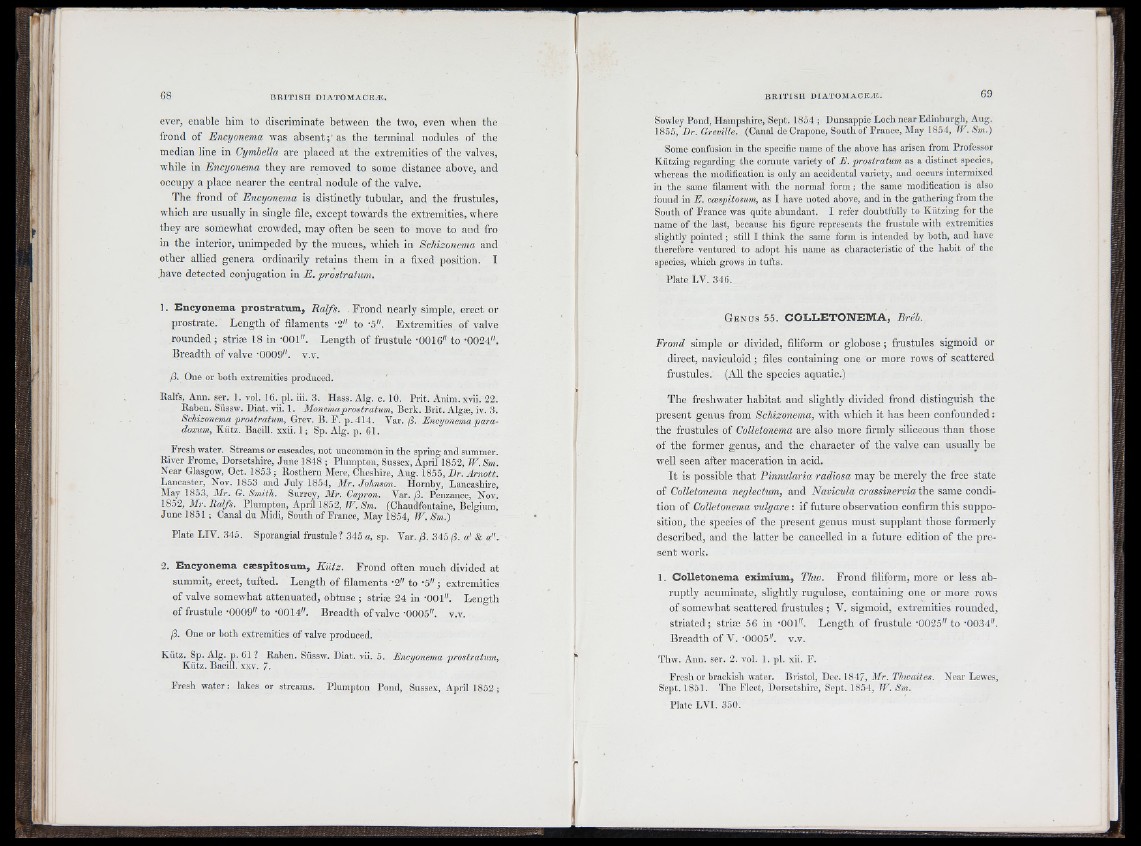
ñ .
ever, enable him to discriminate between the two, even when the
irond of Encyonema was absent; as the terminal nodules of the
median line in Cymbella are placed at the extremities of the valves,
while in Encyonema they are removed to some distance above, and
occupy a place nearer the central nodule of the valve.
The frond of Encyonema is distinctly tubular, and the frustules,
which are usually in single file, except towards the extremities, where
they are somewhat crowded, may often be seen to move to and fro
in the interior, unimpeded by the mucus, which in Schizonema and
other allied genera ordinarily retains them in a fixed position. I
have detected conjugation in E . prostratum.
Sowley Pond, Hampshire, Sept. 1854 ; Duusappie Loch near Edinburgh, Aug.
1855, Hr. Greville. (Canal de Crapone, South of France, May 1854, W. Sm.)
Some confusion in the specific name of the above has arisen from Professor
Kützing regarding the cornute variety of E. prostratum as a distinct species,
whereas the modification is only an accidental variety, and occurs intermixed
in the same filament with the normal form; the same modification is also
found in E. ccespitosum, as I have noted above, and in the gathering from the
South of France was quite abundant. I refer doubtfully to Kützing for the
name of the last, because his figure represents the frustule with extremities
slightly pointed; still I think the same form is intended hy both, and have
therefore ventured to adopt his name as characteristic of the habit of the
species, which grows in tufts.
Plate LV. 346.
] . Encyonema prostratum, Ralfs. Frond nearly simple, erect or
prostrate. Length of filaments '2" to ‘5". Extremities of valve
rounded; striæ 18 in -OOl''. Length of frustule -0016" to -0024".
Breadth of valve '0009". v.v.
ft. One or both extremities produced.
Ralfs, Ann. ser. 1. vol. 16. pl. iii. 3. Hass. Alg. c. 10. Prit. Anim. xvii. 22.
Raben. Süssw. Diat. vii. 1. Monemaprostratum. Berk. Brit. Algæ, iv. 3.
Schizonema prostratum, Grev. B. F. p. 414. Var. ft. Encijonema para-
doxum, Kiitz. Bacill. xxii. 1; Sp. Alg. p. 61.
Fresh water. Streams or cascades, not uncommon in the spring and summer.
River Frome, Dorsetshire, June 1848 ; Plumpton, Sussex, April 1852, W.Sm.
Near Glasgow, Oct. 1853 ; Rosthern Mere, Cheshire, Aug. 1855, Dr. Arnott.
Lancaster, Nov. 1853 and July 1854, Mr. Johnson. Hornby, Lancashire,
May 1853, Mr. G. Smith. Surrey, Mr. Capron. Var. ft. Penzance, Nov.
1852, Mr. Ralfs. Plumpton, April 1852, W. Sm. (Chaudfontaine, Belgium,
June 1851 ; Canal du Midi, South of France, May 1854, IF, Sm.)
Plate LIV. ,345. Sporangial frustule? 345 «, sp. Var./3. 345/3. « '& a".
2. Encyonema cæspitosum, Kütz. Frond often much divided at
summit, erect, tufted. Length of filaments -2" to -5" ; extremities
of valve somewhat attenuated, obtuse ; striæ 24 in -OOl". Length
of frustule -0009" to -0014". Breadth of valve -0005". v.v.
ft. One or both extremities of valve produced.
Kiitz. Sp. Alg. p. 61 ? Raben. Süssw. Diat. vii. 5. Encyonema prostratum,
Kütz. Bacill. XXV. 7.
Fresh water: lakes or streams. Plumpton Pond, Sussex, April 1852;
| i i:
G e n u s 55. COLLETONEMA, Bréb.
Frond simple or divided, filiform or globose ; frustules sigmoid or
direct, naviculoid ; files containing one or more rows of scattered
frustules. (All the species aquatic.)
The freshwater habitat and slightly divided frond distinguish the
present genus from Schizonema, with which it has been confounded :
the frustules of CoUetonema are also more firmly siliceous than those
of tlie former genus, and the character of the valve can usually be
well seen after maceration in acid.
I t is possible that Pinnularia radiosa may be merely the free state
of CoUetonema neglectum, aud Navicula crassinervia the same condition
of CoUetonema vulgare : if future observation confirm this supposition,
the species of the present genus must supplant those formerly
described, and the latter be cancelled in a future edition of the present
work.
1. CoUetonema eximium, Tim. Frond filiform, more or less abruptly
acuminate, slightly rugulose, containing one or more rows
of somewhat scattered frustules ; V. sigmoid, extremities rounded,
striated; striæ 56 in 'OOl". Length of frustule ■0023" to -0034".
Breadth of V. -OOOS". v.v.
Thw, Ann. ser. 2. vol. 1. pl. xii. F.
Fresli or brackisli water. Bristol, Dec. 1847, Mr. Thwaites. Near Lewes,
Sept. 1851. The Fleet, Dorsetshire, Sept. 1851, W. Sm.
Plate LVI. 350.